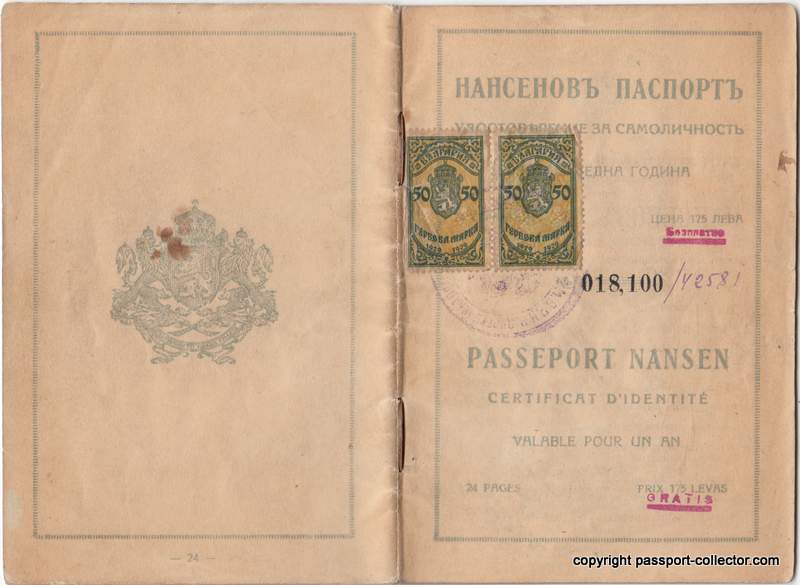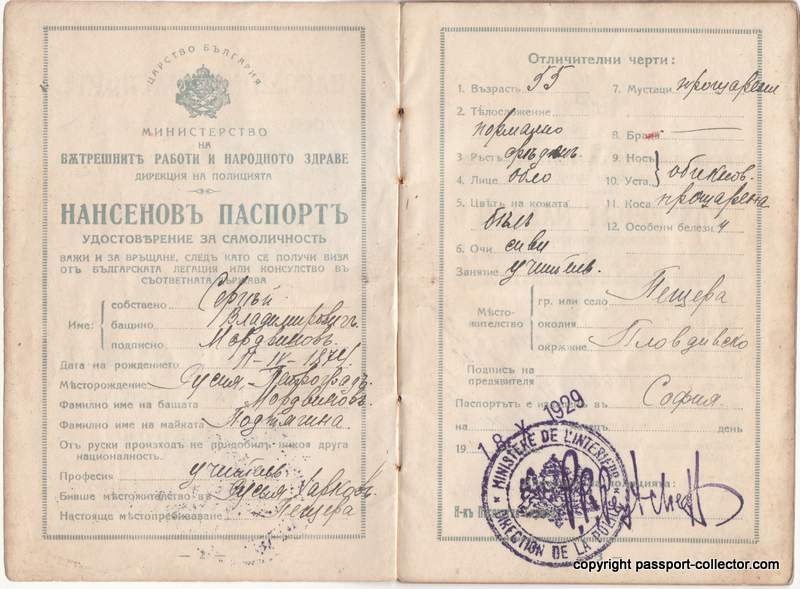Bulgarian Nansen passport for multiple people
The Nansen Office was established as an autonomous institution, with humanitarian aims, under the League of Nations’ auspices. It was to offer the refugees all the material support that its funds would permit. On the other hand, according to the League of Nations Assembly’s decision, political and legal protection was to be vested in the League’s Secretariat. In actual fact, however, this function also passed to the Nansen Office, for the Secretariat did not possess the administrative machinery it would have needed in the various countries and localities to give the practical daily assistance in legal and political matters that have proved to be so essential. The League of Nations Secretariat has, of course, played a leading part in elaborating the different international agreements that have gradually been concluded for the assistance and protection of the refugees. Still, otherwise, it has found it expedient to leave the refugee work almost entirely to the Nansen Office. Nansen passport
The funds at the disposal of the Nansen Office at the time of its creation were insignificant. Still, they were substantially augmented, partly by a British government’s contribution and partly by a donation of 250.000 Norwegian kroner from Nansen’s estate. This amount no doubt represented the balance, with interest and compound interest, of the Peace Prize that Nansen himself had received and of the equivalent sum given to him by Christian Erichsen4. Nansen had used the remainder to set up a model farm in Russia after the famine.
However, the need was so great, and the demands for aid to the disabled, the old, the sick, and all those who had to be rehabilitated, so extensive, that the Nansen Office’s resources dwindled rapidly. The situation was helped by the intergovernmental agreement of 1926, which stipulated that the document commonly called the Nansen Passports – actually for most refugees the identity card required in many countries – be subject to a levy of five gold francs for each issue or renewal. One by one, many countries adopted this system, and the fee has now become the most important source of revenue for the Nansen Office, especially since its introduction in France, which harbors such a large number of Russian and Armenian refugees, along with most of those from the Saar. In other words, it is the refugees themselves who cover the greater part of the cost of the humanitarian work done by the Nansen Office. It is important to bear this in mind. Meanwhile, the sale of stamps issued by both the Norwegian and French governments in aid of the refugees has produced gratifying results. Norway’s response has been particularly substantial when measured in proportion to this country’s small population: the Nansen Office’s income from the Norwegian stamps has so far reached a good 150.000 Norwegian kroner. Voluntary gifts have also played their part. Nansen passport
This committee is entirely independent of the League of Nations. Still, it is intended to collaborate with the League’s High Commission in their common field of interest, namely, refugees’ movement to overseas countries. The first task of the Intergovernmental Committee should be to open negotiations with the German authorities to secure for German refugees the right to take with them a certain part of their assets, and in general to establish some cooperation in helping these unfortunate people to emigrate to other countries.
The idea underlying the formation of this committee was the conciliatory one – which will, I am convinced, one day prevail – that it ought to be possible to come to an arrangement that seems so eminently reasonable, and that will in any case clearly benefit a country wishing to be rid of so many of its subjects. In the long run, Germany can have no interest in obstructing the emigration it has itself planned or in imposing such great burdens on its neighbors.
And how heavy these burdens are! Dr. Goebbels said recently that about 180,000 Germans, mainly Jews, have left Germany during the last few years but that the new Germany, with its population of eighty million, still has about 700.000 Jews who must get out.
But this is not all. Animosity toward the Jews is spreading like a plague over many countries, especially in southern and Eastern Europe.
Such is Europe’s situation in the twentieth century, after the Peace of Versailles and after the Pact of Munich. And yet things can become even worse, for if there is no armistice in Spain or peace with amnesty for those who in one way or another are regarded as political criminals, the number of refugees who will once more flood Europe, and naturally France first, can reach one to two million.
Fridtjof Nansen saw his work as a real contribution to peace. So too did the League of Nations, and when Fridtjof Nansen was dead, the Assembly paid solemn tribute to his memory for his efforts “to unite the nations in work for the cause of peace.”
The Passport Nansen passport
a Bulgarian travel document which includes the wording PASSPORT NANSEN & IDENTITY CERTIFICATE. The document was issued on 18 October 1929 in Sofia to a 55 years old Russian man (Serge Vladomirowitch?) from Petrograd, including two family members, a woman and another man at the age of 49. The document includes three passport photos. But wait, the entry on page nine is stating another person in the name of Elisabeth Torimonoff (?). Elisabeth was added in November, the same year. I never saw a NANSEN document issued for more than one person, but this example includes FOUR people. This is outstanding!
Furthermore, the document has visas from France, issued in Sofia, a transit visa for Switzerland, issued in Sofia. An Austrian transit visa to France and a visa from Serbia & Slovenia. Page 14/15 some Serbia/Slovenia stamps. The passport has 24 pages and three Bulgarian revenue stamps. The condition is excellent.
To my best knowledge, only Bulgaria, Latvia, and Romania issued NANSEN BOOKLETS! But ONLY Bulgaria had the wording NANSEN PASSPORT!
A scarce issue is also this Danzig Nansen
FAQ Passport History
Passport collection, passport renewal, old passports for sale, vintage passport, emergency passport renewal, same day passport, passport application, pasaporte passeport паспорт 护照 パスポート جواز سفر पासपोर्ट
1. What are the earliest known examples of passports, and how have they evolved?
The word "passport" came up only in the mid 15th Century. Before that, such documents were safe conducts, recommendations or protection letters. On a practical aspect, the earliest passport I have seen was from the mid 16th Century. Read more...
2. Are there any notable historical figures or personalities whose passports are highly sought after by collectors?
Every collector is doing well to define his collection focus, and yes, there are collectors looking for Celebrity passports and travel documents of historical figures like Winston Churchill, Brothers Grimm, Johann Wolfgang von Goethe. Read more...
3. How did passport designs and security features change throughout different periods in history, and what impact did these changes have on forgery prevention?
"Passports" before the 18th Century had a pure functional character. Security features were, in the best case, a watermark and a wax seal. Forgery, back then, was not an issue like it is nowadays. Only from the 1980s on, security features became a thing. A state-of-the-art passport nowadays has dozens of security features - visible and invisible. Some are known only by the security document printer itself. Read more...
4. What are some of the rarest and most valuable historical passports that have ever been sold or auctioned?
Lou Gehrig, Victor Tsoi, Marilyn Monroe, James Joyce, and Albert Einstein when it comes to the most expensive ones. Read more...
5. How do diplomatic passports differ from regular passports, and what makes them significant to collectors?
Such documents were often held by officials in high ranks, like ambassadors, consuls or special envoys. Furthermore, these travel documents are often frequently traveled. Hence, they hold a tapestry of stamps or visas. Partly from unusual places.
6. Can you provide insights into the stories behind specific historical passports that offer unique insights into past travel and migration trends?
A passport tells the story of its bearer and these stories can be everything - surprising, sad, vivid. Isabella Bird and her travels (1831-1904) or Mary Kingsley, a fearless Lady explorer.
7. What role did passports play during significant historical events, such as wartime travel restrictions or international treaties?
During war, a passport could have been a matter of life or death. Especially, when we are looking into WWII and the Holocaust. And yes, during that time, passports and similar documents were often forged to escape and save lives. Example...
8. How has the emergence of digital passports and biometric identification impacted the world of passport collecting?
Current modern passports having now often a sparkling, flashy design. This has mainly two reasons. 1. Improved security and 2. Displaying a countries' heritage, icons, and important figures or achievements. I can fully understand that those modern documents are wanted, especially by younger collectors.
9. Are there any specialized collections of passports, such as those from a specific country, era, or distinguished individuals?
Yes, the University of Western Sidney Library has e.g. a passport collection of the former prime minister Hon Edward Gough Whitlam and his wife Margaret. They are all diplomatic passports and I had the pleasure to apprise them. I hold e.g. a collection of almost all types of the German Empire passports (only 2 types are still missing). Also, my East German passport collection is quite extensive with pretty rare passport types.
10. Where can passport collectors find reliable resources and reputable sellers to expand their collection and learn more about passport history?
A good start is eBay, Delcampe, flea markets, garage or estate sales. The more significant travel documents you probably find at the classic auction houses. Sometimes I also offer documents from my archive/collection. See offers... As you are already here, you surely found a great source on the topic 😉
Other great sources are: Scottish Passports, The Nansen passport, The secret lives of diplomatic couriers
11. Is vintage passport collecting legal? What are the regulations and considerations collectors should know when acquiring historical passports?
First, it's important to stress that each country has its own laws when it comes to passports. Collecting old vintage passports for historical or educational reasons is safe and legal, or at least tolerated. More details on the legal aspects are here...
Does this article spark your curiosity about passport collecting and the history of passports? With this valuable information, you have a good basis to start your own passport collection.
Question? Contact me...










